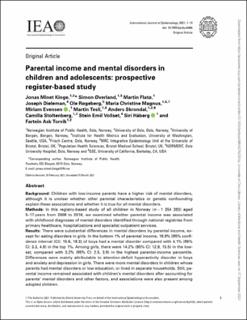| dc.contributor.author | Kinge, Jonas Minet | |
| dc.contributor.author | Øverland, Simon Nygaard | |
| dc.contributor.author | Flatø, Martin | |
| dc.contributor.author | Dieleman, Joseph | |
| dc.contributor.author | Røgeberg, Ole Jørgen | |
| dc.contributor.author | Magnus, Maria Christine | |
| dc.contributor.author | Evensen, Miriam | |
| dc.contributor.author | Tesli, Martin Steen | |
| dc.contributor.author | Skrondal, Anders | |
| dc.contributor.author | Stoltenberg, Camilla | |
| dc.contributor.author | Vollset, Stein Emil | |
| dc.contributor.author | Håberg, Siri Eldevik | |
| dc.contributor.author | Torvik, Fartein Ask | |
| dc.date.accessioned | 2021-09-21T05:55:33Z | |
| dc.date.available | 2021-09-21T05:55:33Z | |
| dc.date.created | 2021-09-17T12:04:13Z | |
| dc.date.issued | 2021 | |
| dc.identifier.issn | 0300-5771 | |
| dc.identifier.uri | https://hdl.handle.net/11250/2779692 | |
| dc.description.abstract | Background
Children with low-income parents have a higher risk of mental disorders, although it is unclear whether other parental characteristics or genetic confounding explain these associations and whether it is true for all mental disorders.
Methods
In this registry-based study of all children in Norway (n = 1 354 393) aged 5–17 years from 2008 to 2016, we examined whether parental income was associated with childhood diagnoses of mental disorders identified through national registries from primary healthcare, hospitalizations and specialist outpatient services.
Results
There were substantial differences in mental disorders by parental income, except for eating disorders in girls. In the bottom 1% of parental income, 16.9% [95% confidence interval (CI): 15.6, 18.3] of boys had a mental disorder compared with 4.1% (95% CI: 3.3, 4.8) in the top 1%. Among girls, there were 14.2% (95% CI: 12.9, 15.5) in the lowest, compared with 3.2% (95% CI: 2.5, 3.9) in the highest parental-income percentile. Differences were mainly attributable to attention-deficit hyperactivity disorder in boys and anxiety and depression in girls. There were more mental disorders in children whose parents had mental disorders or low education, or lived in separate households. Still, parental income remained associated with children’s mental disorders after accounting for parents’ mental disorders and other factors, and associations were also present among adopted children.
Conclusions
Mental disorders were 3- to 4-fold more prevalent in children with parents in the lowest compared with the highest income percentiles. Parents’ own mental disorders, other socio-demographic factors and genetic confounding did not fully explain these associations. | en_US |
| dc.language.iso | eng | en_US |
| dc.publisher | Oxford University Press | en_US |
| dc.rights | Navngivelse 4.0 Internasjonal | * |
| dc.rights.uri | http://creativecommons.org/licenses/by/4.0/deed.no | * |
| dc.title | Parental income and mental disorders in children and adolescents: prospective register-based study | en_US |
| dc.type | Journal article | en_US |
| dc.type | Peer reviewed | en_US |
| dc.description.version | publishedVersion | en_US |
| dc.rights.holder | Copyright The Author(s) 2021 | en_US |
| dc.source.articlenumber | dyab066 | en_US |
| cristin.ispublished | true | |
| cristin.fulltext | original | |
| cristin.qualitycode | 2 | |
| dc.identifier.doi | 10.1093/ije/dyab066 | |
| dc.identifier.cristin | 1935363 | |
| dc.source.journal | International Journal of Epidemiology | en_US |
| dc.relation.project | Norges forskningsråd: 262700 | en_US |
| dc.relation.project | Norges forskningsråd: 262030 | en_US |
| dc.relation.project | Norges forskningsråd: 300668 | en_US |
| dc.identifier.citation | International Journal of Epidemiology. 2021, dyab066. | en_US |

